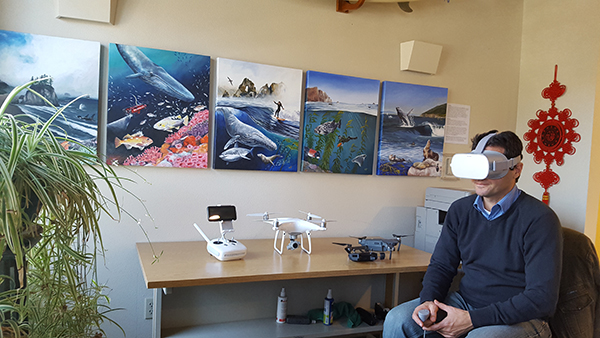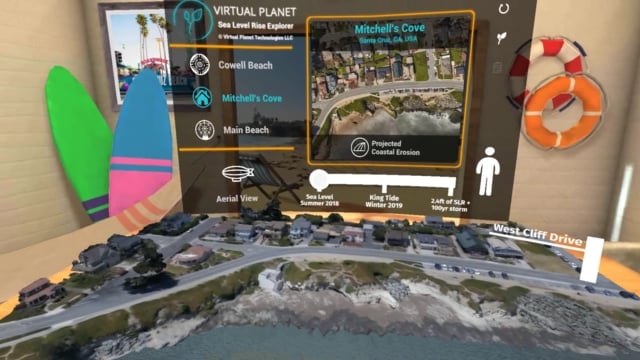Virtual Reality "Sea Level Rise Explorer" Helps the City of Santa Cruz

When virtual reality software puts you in a 3D world, seeing your familiar coastline inundated by rising seas and storm surge—the impact is visceral.
Dr. Juliano Calil, Center for the Blue Economy Senior Fellow, Adjunct Faculty at the Middlebury Institute, and co-founder of Virtual Planet has created a 3D virtual reality “Sea Level Rise Explorer.” It depicts three locations in Santa Cruz: the main Beach Boardwalk and surrounding neighborhoods, Mitchell’s Cove off West Cliff Drive, and Cowells Beach, a globally popular surfing destination. For each location, the viewer can experience the beaches at summer 2018 levels, during a King Tide, and the witness the stunning projection of 2.4 feet of sea level rise in combination with a 100-year storm.
Santa Cruz has long been a leader in coastal adaptation planning in California. Under the direction of Dr. Tiffany Wise-West,Sustainability & Climate Action Manager for the City of Santa Cruz, the city plans to make use of Dr. Calil’s VR technology. “I am very happy that the City is working with our company to bring our virtual reality experience to its public outreach efforts,” writes Dr. Calil. “Using our application, the general public, or anyone with an interest in the coastal zone, really, will be able to visualize complex coastal issues in a fully immersive and interactive environment.”
“Part of the project with the City of Santa Cruz is looking at adaptation options to reduce these risks. The goal is to drive a discussion about solutions.”
The VR presentation is strategically short, designed so that the City of Santa Cruz can present it to the community at a series of outreach events discussing climate change and the impacts to the city. The second phase of development for this software will include possible solutions. “The final version of the experience will also include hyper realistic 3d models of proposed adaptation actions, an interactive survey, and will also be available in Spanish. We hope the experience will promote a healthy conversation about the multiple tradeoffs involved in this complex process. We are also developing a phone-based app that will be available later this year„” writes Dr. Calil.

Dr. Calil has a passion for technology, and he was looking for ways to use virtual reality to highlight the challenges of climate change. During his PhD research, he examined the impacts of climate change on the Gulf Coast, but quickly realized that the way researchers typically denote value along the coast focuses narrowly on “averted costs” based on property values or business income—which leaves communities of more modest income seemingly less “cost effective” to protect. He adapted his research to incorporate a more multi-disciplinary approach capturing many data points: sea level rise, wave energy, storm damage, property values, but also population, mortality rates, and social vulnerability. With multi-point data and the ability to visually layer these considerations with future storm and sea level rise predictions, he was able to provide three key indicators of high priority lands, high flood risk, and high social vulnerability. The hope is that this type of nuanced discussion of sea level rise and climate adaptation solutions will be facilitated by VR technology.
Our team is broadly interested in applications aiming at promoting prosocial behavior change related to climate change, equitable adaptation, and conservation issues.

Development of the “Sea Level Rise Explorer” VR technology began in earnest in late July of 2018. The Virtual Planet team includes Dr. Calil (scientist and data expert with a PH.D. in ocean science and coastal adaptation and certified drone pilot), Paulo Salvatore (veteran game designer, and user experience expert), Gianluca Tessicini (senior developer), and Marcel Casarini (Canada market). The development includes flying drones over the areas of land depicted, each drone taking 200-600 photos from the air at each location, then working with “photogrammetry” using GPS, triangulation and geometry to identify 40,000 points of similarity between the photos. The software then selects 4000 of the best overlapping points in each image to create the final 3D models that are inserted in the VR experience. Dr. Calil was able to go out on Jan.21stduring the last King Tide to fly the drones. “I was very lucky, it was a beautiful sunny day.” Working with erosion models from the USGS, photogrammetry software, and Salvatore’s development expertise, they were able to create a seamless VR experience.
“Ultimately, we want to develop engaging tools that will help cities to identity priority communities to receive climate adaptation, economic development, and risk reduction investments.”
What are the future plans for development of the Sea Level Rise Explorer? “We are interested in partnering with a second coastal location this year, to explore a few new exciting features we have planned for future releases,” writes Dr. Calil. “Finally, we are also planning to expand the scope of our experience beyond sea level rise and coastal erosion.” The Center for the Blue Economy is also part of a team assisting the City of Santa Cruz to evaluate options to address sea level rise in the West Cliff Drive area. This work over the next year will link the Center’s capabilities in the economic analysis of options with Dr. Calil’s virtual reality capabilities to help the City identify the best options.
For More Information
About Dr. Juliano Calil
About Virtual Planet
Virtual Planet Website

